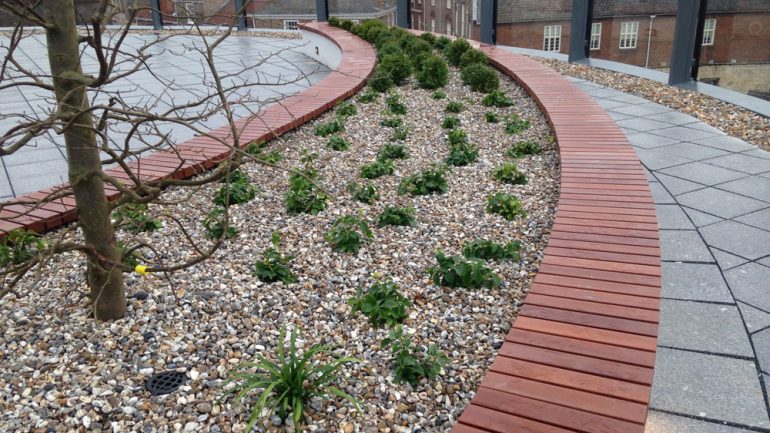It is widely acknowledged and accepted that green spaces are important to health and wellbeing. Numerous studies have shown that utilising green spaces boosts the wellbeing of urban dwellers; improving both physical and mental health.
With space being at a premium, planners and designers in towns and cities have been rising to the challenge of coming up with creative solutions. Creating green spaces on top of buildings, known as Roof Gardens, Green Roofs or roof garden terraces has been one such response and has proved popular with designers, planners and citizens. Green spaces on roofs which are accessible to the local community as a social space for citizens to relax and enjoy nature is becoming increasingly common in new development plans.
So, as well as the health benefits are there any others to justify the cost? Quite simply, yes – numerous! Green roofs are a simple means of supporting and increasing bio-diversity. By planting wildflowers, sedum or other flowering plants a green roof space can provide a range of ecosystem services and mitigates the ecological impact of construction. There are huge benefits to the environment by reducing air and noise pollution. As with any green-covered planted area, a green roof will help to lower levels of CO2(carbon dioxide) in the air which has an overall positive effect on the local environment as well as contributing to the wider global warming issue. Green roofs are widely acknowledged to counter the urban heat island effect and aid with flooding by slowing down storm water or attenuating it via a Blue Green roof.
Its worth noting that including a green roof in your planning might make it easier to gain planning permission. BREEAM (the Building Research Establishment’s Environmental Assessment Method) is a method used to assess a development or building’s sustainability with regard to a series of ten different categories. Incorporating a green roof into your project will earn you BREEAM points, the number will depend on a number of factors which includes the purpose of the green roof, whether for energy efficiency, ecology etc
Installing a roof garden, green roof or roof garden terrace is not without its challenges. During the planning and design stage considerations need to be given to site access, health and safety features, over-looking neighbouring properties, accessibility for citizens, load-bearing capacity, drainage and ongoing maintenance and management.
There are many specialist organisations to guide you through the process and well-respected suppliers, like Green-tech who can supply many of the key elements for a successful green roof space. This will include insulation, waterproofing materials, weed control membranes, roof drainage systems, filter membranes, green roof vegetation and roof garden substrates for podium roofs and intensive and extensive roof garden constructions.
Each component contributes to a successful green roof project but for healthy plants, shrubs and trees to thrive your choice of soil is essential. It is critical that a specialist roof garden substrate is selected as you will need it to be light weight and have good nutrient content and water holding properties – all key ingredients for a successful recipe.
The Green-tree brand of soils and substrates has been successfully installed in many green roof projects throughout the country. With 25 production sites across the UK, the range of Green-tree roof substrates was developed in partnership with landscape and roofing contractors, architects and designers to produce environmentally sustainable substrates that thrive in harsh rooftop environments. Green-tree have a choice of substrates with different soil profiles to suit all green roof and podium roof installations.


